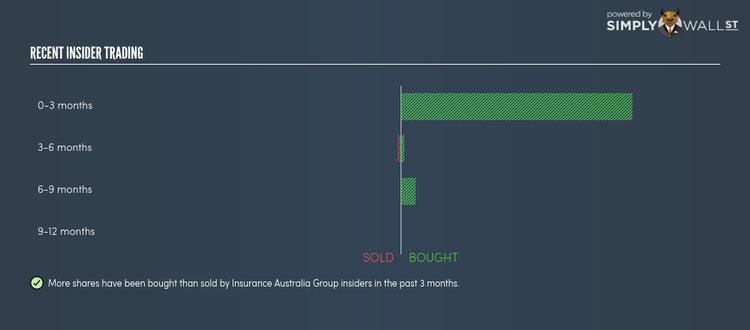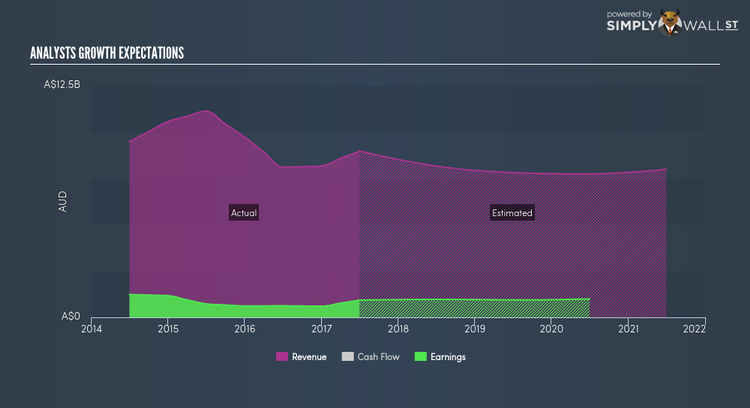Insurance Australia Group Limited’s (ASX:IAG) Insiders Recently Ramped Up Their Holdings – Should You?

Insurance Australia Group Limited underwrites general insurance products. Insurance Australia Group’s insiders have invested more than 119 million shares in the large-cap stocks within the past three months. A well-known argument is that insiders investing more in their own companies’ shares sends an optimistic signal. A two-decade research published in The MIT Press (1998) showed that stocks following insider buying outperformed the market by 4.5%. However, it may not be sufficient to base your investment decision merely on these signals. Today we will evaluate whether these decisions are bolstered by analysts’ expectations of future growth as well as recent share price movements.
See our latest analysis for Insurance Australia Group
Who Are Ramping Up Their Shares?
More shares have been bought than sold by Insurance Australia Group insiders in the past three months. In total, individual insiders own over 3 million shares in the business, which makes up around 0.14% of total shares outstanding. .
The entity that bought on the open market in the last three months was
Capital Research and Management Company. Although this is an institutional investor, rather than a company executive or board member, the insights gained from direct access to management as a large investor would make it more well-informed than the average retail investor. In this specific instance, I would classify this investor as a company insider.
Is This Consistent With Future Growth?
Analysts’ expectations for earnings over the next 3 years of 5.22% provides a tamed outlook moving forward, however, insiders may be more optimistic than the market, with their net buying activity. Digging deeper into the line items,Insurance Australia Group is believed to experience decline in top-line growth next year, which could imply some headwinds going forward. However, next year’s earnings expectations still exhibit a slight positive growth of 4.33% which may indicate a relatively effective cost management in order to bring the company back to positive earnings. Insiders increasing their holding could show they have confidence in the company’s ability to continue growing. They may believe it is nearing the end of a turnaround or merely feel the market has discounted the stock too heavily, providing a prime opportunity to buy.
Did Insiders Buy On Share Price Volatility?
Alternatively, the timing of these insider transactions may have been driven by share price volatility. This means, if insiders believe shares were heavily undervalued recently, this would provide a prime opportunity to buy more irrespective of its growth outlook. Insurance Australia Group’s shares ranged between A$7.75 and A$7.07 over the past three months. This indicates a relatively insignificant share price movement, with a small change of 9.62%. This may mean insiders’ motivation to trade may not be driven by the share price but rather other factors such as their belief in company growth or their personal portfolio rebalancing.
Next Steps:
Insurance Australia Group’s insider meaningful buying activity tells us the shares are currently in favour, which is fairly consistent with earnings growth expectations, even if the low share price volatility did not warrant exploiting any mispricing. Although insider buying can be a useful prompt, following the lead of an insider, however, will never replace diligent research. there are two important aspects you should further examine:
1. Financial Health: Does Insurance Australia Group have a healthy balance sheet? Take a look at our free balance sheet analysis with six simple checks on key factors like leverage and risk.
2. Other High Quality Alternatives : Are there other high quality stocks you could be holding instead of Insurance Australia Group? Explore our interactive list of high quality stocks to get an idea of what else is out there you may be missing!
NB: Figures in this article are calculated using data from the last twelve months, which refer to the 12-month period ending on the last date of the month the financial statement is dated. This may not be consistent with full year annual report figures.
To help readers see pass the short term volatility of the financial market, we aim to bring you a long-term focused research analysis purely driven by fundamental data. Note that our analysis does not factor in the latest price sensitive company announcements.
The author is an independent contributor and at the time of publication had no position in the stocks mentioned.


